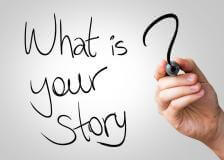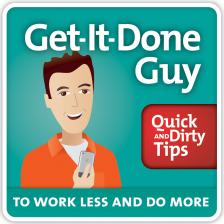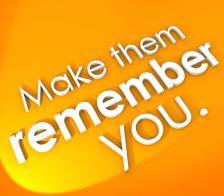How to Be Memorable (Part 2): Crafting a Story
Storytelling is the foundation for effective, memorable communication. Once you’ve hooked your audience, you need characters, plot arcs, and resolution to make the story stick. Get-It-Done Guy explains how to tell memorable stories.

He claimed that I’m a genius at telling stories, while I modestly protested that it’s nothing special. I’ve since discovered I was wrong! I am a genius, and for an appropriate fee, am thrilled to apply my genius to help you create a compelling, memorable story that raises money, acquires customers, gets you a job, or helps you become a powerful leader who can take over the world. Just visit www.SteverRobbins.com to contact me.
Getting back to the point, in the first episode of this storytelling series, we discovered why stories are so memorable, how your content becomes the plot of the story, and how we need to begin a story so people get drawn in and want to hear the rest. That episode was all about the conceptual, planning parts of the story. Today, we’ll discuss creating the specifics.
This episode is brought to you by NatureBox. Discover smarter snacking with a new NatureBox each month. Get your first box FREE when you go to NatureBox.com/qdt.
Creativity Demands a Notepad
First and foremost, grab a little 3×5″ notepad and a pencil and carry it around with you everywhere.
A lot of the ideas for stories come from real life and you want to be able to jot them down quickly and easily. Use a paper and pencil because (as I’ve mentioned in previous episodes) research shows that handwritten notes get retained more thoroughly than electronic notes. You want that. You want it all bouncing around in your unconscious so they come out when you need them. A computer can log your ideas, but they won’t come to mind when you need your creativity.
Find Characters in Real Life
Every good story needs characters. Characters are easy. I just take them from real life. When you meet someone and think, “What a character!” write them down! Make a few notes on to their defining characteristics, so you can weave those into your story. Voila, you have your next protagonist!
Here’s my cast of chacters: Bernice and Melvin are based on my real-life high school friends Becky and Everett. Becky was a strong-willed owner of her own store and Everett was a computer geek.
When something in real life excites, charms, alarms, or mystifies you, use it!
Europa comes from the 1981 song “Europa and the Pirate Twins” and the mid-1990s sequel, Eastern Bloc. With a name like Europa and a background as a pop star, it was obvious that she simply had to be the secret mastermind controller of the entire Eastern Bloc. Thomas, her android son, is of course the composer of those songs, Thomas Dolby. Why an android? Because I always thought Dolby’s hit song “She Blinded Me with Science” was about an android. I was wrong, but the association seemed fun, so I kept it.
Europa and Thomas made their debut when I heard that Dolby was about to release his first new album in years and the characters were my way of paying homage. Plus, Europa gives me a character who is a business expert, so she can chime in on certain topics in a way that the other characters can’t.
Grandma Cuddles is completely fictional. Audrey 2 is the man-eating plant from the musical Little Shop of Horrors. MG, the new intern, is a real person, investigative journalist MG Lee, and he is voiced by the real MG.
Characters Develop Personality and Story Arcs
Once you have characters, you need a story. As I said in Part 1 of this series on how to be memorable, my story is often just the tip. The basic elements of a story are a goal that the characters want, a conflict that keeps them from getting there, and the story is the journey around the conflict. The goal can be an external goal, like taking over the world with a zombie army and cornering the world supply of Oreo Ice Cream Cake, which coincidentally is the plot of my Zombie musical. Check it out at WorkLessAndDoMore.com. The goal can be internal, like resolving the conflict, falling in love, and so forth.
Sometimes the story gets resolved in a single episode. There’s a problem putting together the Audrey 2 watering system, and it gets solved via that episode’s tip. I also have a looser story arc going on about Bernice and Melvin’s wedding. Originally, Bernice was planning it without letting Melvin know they were getting married. He figured it out, and the wedding is on. I just don’t know when, yet, or what surprising thing will happen to create a plot twist.
Capture Humor!
When you come up with a funny joke, or a situation you might want to work into your story, write it down! Writing it down pounds it into your brain. Later, it may come back on its own, or you can browse your notes to add some humor.
Over lunch, I realized that Grandma Cuddles runs a summer camp for Brain Development and Focus to help her distractible young campers learn to concentrate. She likes to think of it as her own little “concentration camp” for short. (…Too soon?)
Find the Awesome in Real Life
I’m not very good at coming up with fictional scenarios, so I steal a lot from real life. When something in real life excites, charms, alarms, or mystifies you, use it! In my episode on measurement, I mention that I can only do 12 pull-ups, and MG does 64 every time he works out. That whole exchange was real. I was so proud of my pull-ups…and he supportively shared that he does 6 times as many as I do. Daily.
Another scene from real life: I went to Sleep No More, a retelling of Macbeth through interpretive dance. It’s performed in an empty school where every room has been transformed into a scene from the play. There’s a lounge with a live jazz quartet when you can go relax, if it gets too overwhelming. At one point, Macbeth pushed by me and I got covered with some of his blood (stage blood).
Afterwards, we relaxed in the jazz lounge for a drink, when a delightful young woman asked if she could share our table. The wonderful Laura Michelle Kelly turned out to be the Olivia Award-winning actress who was playing Mary Poppins on Broadway. Fun story, right? With a little massaging, it becomes: There I was, listening to a jazz quartet in an abandoned high school, covered in Macbeth’s blood, when who should sit down but Mary Poppins. I have the best life!
If you’re going to spice up a presentation or writing with a story, first hook the audience with a situation, complication and question, as discussed in Part 1 of this series. Bring in some characters from real life or fiction. Then create a goal for them and an obstacle they must overcome. Have them overcome the obstacle in a way that weaves in what you’re presenting. Capture and use the humor you encounter in daily life, as well as everyday situations, that can be retold as something extraordinary.

I hope these tips will help you come up with some great stories for your presentations. I’d love to hear all about your successes (and failures). Connect with me on Facebook, Twitter, and LinkedIn.
You May Also Like…







